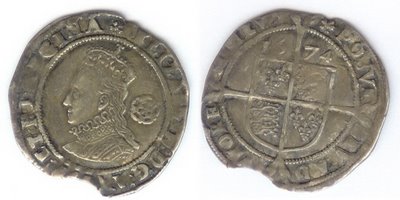Elizabeth I (17 Nov 1558 - 24 March 1603) Coinage and History

Over time I hope to post images of some of the coins in my collection and bit of the history around them.
HOUSE OF TUDOR
Elizabeth I (17 Nov 1558 - 24 March 1603) - born 7th September 1533
The Virgin Queen Elizabeth or ‘Gloriana’ un-did Catholic Mary’s work as England reverted to Protestantism and pacified the religious divide. Skilled at politics, she was lucky to be surrounded by talented advisors, but angered them by avoiding the issue of marriage and of course never had children. She assisted Dutch Protestants, and is most famous for defeating her unpopular brother in law, Philip II during the Spanish Armada war of 1588. Her reign is also known for the introduction of the potato and tobacco from the “New World” by Sir Francis Drake. A long and prosperous reign ended in 1603 when Elizabeth died of old age at 75.
A significant reign for coinage as the first machine made pieces were struck from the presses of the Frenchman Eloye Mestrelle in 1561. However they were not popular as production was slow with the horse drawn mill press, though the quality was very good. Mestrelle was dismissed in 1572 and later executed for his collusion with forgers in 1578 some historians believe this may have been engineered by rivals. Elizabeth enjoyed a long reign and this covered many different denominations being issued at various times. The gold crowns were again issued and it was not till 1600 that the large silver crown was again minted. In 1559 the old debased coins of Edward VI were called in for counter marking at a lower face value and the silver fineness was restored to 0.925 by 1582. A new denomination the three-farthings was introduced to help with small change transactions. The first attempt at international trade coins occurred in 1600-01 with the Portcullis Money for use in the East Indies with weights equivalent to the already popular Spanish trade Reales.










